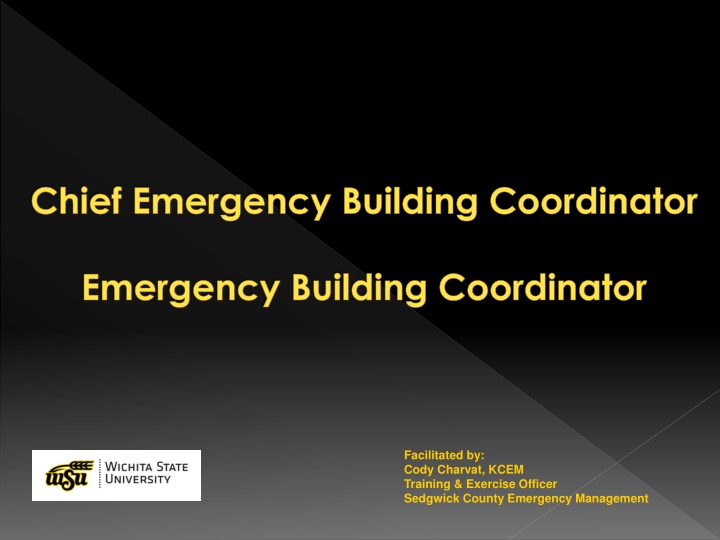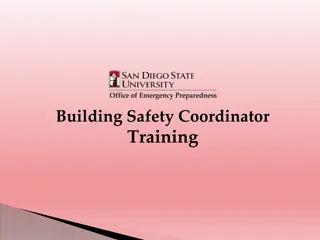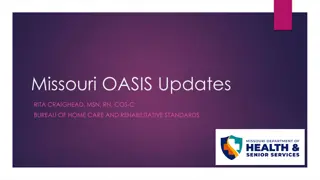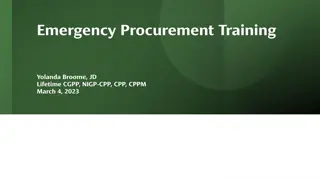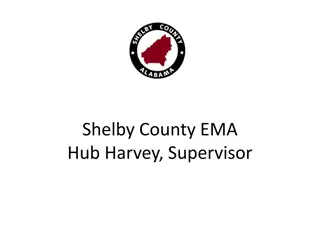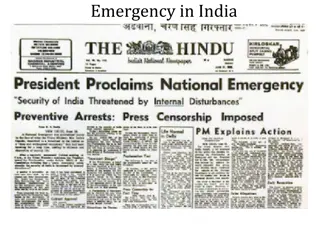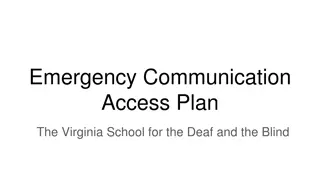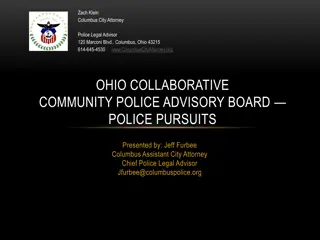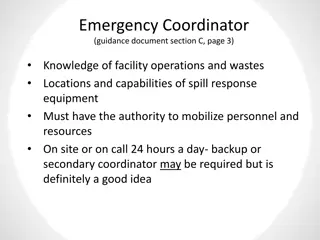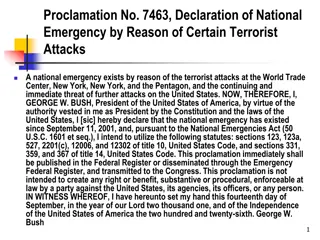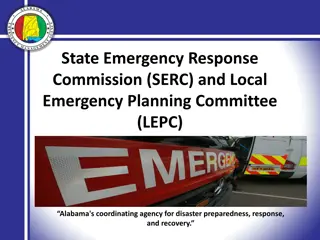Emergency Building Coordinator
Emergency Building Coordinator facilitates emergency management activities, preparing for natural disasters and man-made incidents. Principles include mitigation, preparedness, response, and recovery. The role involves making preparations for unforeseen events that officials may not believe will occur.
Download Presentation

Please find below an Image/Link to download the presentation.
The content on the website is provided AS IS for your information and personal use only. It may not be sold, licensed, or shared on other websites without obtaining consent from the author.If you encounter any issues during the download, it is possible that the publisher has removed the file from their server.
You are allowed to download the files provided on this website for personal or commercial use, subject to the condition that they are used lawfully. All files are the property of their respective owners.
The content on the website is provided AS IS for your information and personal use only. It may not be sold, licensed, or shared on other websites without obtaining consent from the author.
E N D
Presentation Transcript
Chief Emergency Building Coordinator Emergency Building Coordinator Facilitated by: Cody Charvat, KCEM Training & Exercise Officer Sedgwick County Emergency Management
Whats on tap Overview of Emergency Management Where you fit into that picture Basics of Disaster Preparedness What s next?
What is Emergency Management? The governmental function that coordinates and integrates all activities necessary to build, sustain and improve the capability to prepare for, protect against, respond to, recover from, or mitigate against threatened or actual natural disasters, acts of terrorism or man-made disasters. - Post-Katrina Emergency Management Reform Act. 2006
A Better Definition: Emergency Management is the process of making public officials think about things they don t want to think about, spend money they don t have, all to prepare for something they don t believe will ever happen Mike Selves, former Johnson Co. EM, Past- President International Assoc. of Emerg. Mgrs.
Principals of Emergency Management Mitigation Changing the physical environment or campus behaviors Preparedness Planning for the things you cannot change or control Response Managing the incident Recovery Returning to normalcy
WSU Emergency Management CEBC - Chief Emergency Building Coordinator EBC - Emergency Building Coordinator EBC s are charged with making professors and students think about things they don t want to think about, spend time they don t want to surrender, preparing for something they don t believe will ever happen to them.
College/University Gun- Related Events* Virginia Tech 2007 In 2017: K-State - Jan Central St. U, Oh Mar Limestone Coll, SC March U. of W. Florida Mar St. Thomas, MN Apr Utah Valley U. Apr North Lake Coll, Tx May Ravenscroft, IN June UNLV, NV July U. of Arkansas July Texas A&M Sept Tennessee St. Sept St Catherine, MN Sept Akron U., OH Sept USC Oct, HOAX
College/University Weapon Related Events* 2017: 34 US School gun incidents (K12- University) Wichita State University, Fairmount Towers, August 2015 1 Dead Wichita State University, Cessna Stadium lot, July 1993 2 dead, 1 injured
Duties of a CEBC? Creates and maintains Emergency Evacuation Plan for their location Maintains a current roster of EBC names and phone numbers; notifies HR immediately with any changes Coordinates and assists the response of EBC members to all emergencies Ensures all EBCs have completed proper training
Duties of a EBC? Reacts to all emergencies and leads proper procedures Know all emergency exit locations, meeting points and evacuation procedures for their building Immediately provide a building status report to CEBC or emergency responders Visually survey building during emergencies to assure everyone is accounted for Completes all training requirements for the EBC Program
The Basics of Disaster Preparedness: Build a kit The University has a kit(s) for your building Make a Plan WSU has a master plan; it s up to the EBC s to tailor the plan for their building Stay Informed Shocker Alerts, message boards, mobile apps, WEA s, battery-powered radio
Emergency Preparedness Kit Contents: Bag Vest Flashlight/Batteries Whistle * Emergency Instruction Binder Quick Reference Card
Planning: All Hazards Approach At the most basic level the response to disasters or threats can be broken down to two categories: Evacuate Shelter-in-Place
General Emergency Response Plan: Evacuation General Evacuation Information: Remain calm Evacuate the building; check for occupants who may not have heard the signal Offer assistance to disabled individuals and others Shut all doors behind you and proceed as quickly as possible Follow emergency guidelines and directions given by emergency personnel Be sure everyone is accounted for at the Emergency Evacuation Area
General Emergency Response Plan: Shelter-in-Place Some slight variances: Sometimes it doesn t matter exactly where in the building you are, other times that means the difference between life and death. Sometimes you can t waste time worrying about closing/opening windows, sometimes that s exactly what you MUST do Sometimes where you are within the room makes no difference, other times it makes all the difference. BE PREPARED TO ADAPT!
Types of Emergencies Evacuate or Shelter-In-Place? Fire Look for evacuation maps in your kit Tornado Maps in kit, detailed instrux in online trng. Power Outage Gas Leak Flooding Bomb Threats/Suspicious Objects Explosion Chemical Spills/Hazardous Materials Armed Intruder/Active Shooter Earthquake
Planning/Response for Quakes Opposite of tornado safety (mostly): Outside can be better than inside Underground is not always best Whether inside or out, find safe place and stay there! Stand in doorway/arch if you want, more important to look up for things that might fall on you
Staying Informed = Staying Alive Information is available anytime, anywhere: take advantage! Whatever your favorite, have a backup via a different medium Technology no substitute for remaining vigilant
CEBC/EBC Training Program Online Introduction General Overview Classroom Training Emergency Response Online Training Inclement Weather Online Training Active Shooter Classroom Training Emergency Evacuation Plan Online Training Campus Wide Communication and Training Semi-Annual Training/Meeting Annual Training Updates
So Remember Emergency Management is a process, not something we can learn during the event Mitigation, Planning, Response, Recovery No single plan/team can cover every situation. EBC s are the critical link in bringing the broad plan to the individual level The Basics are simple: Build a Kit, Make a Plan, Stay informed. This is just the beginning, make sure you stay on top of your training.
THANK YOU! Chief Emergency Building Coordinator Emergency Building Coordinator General Overview Facilitated by: Cody Charvat, KCEM Training & Exercise Officer Sedgwick County Emergency Management
